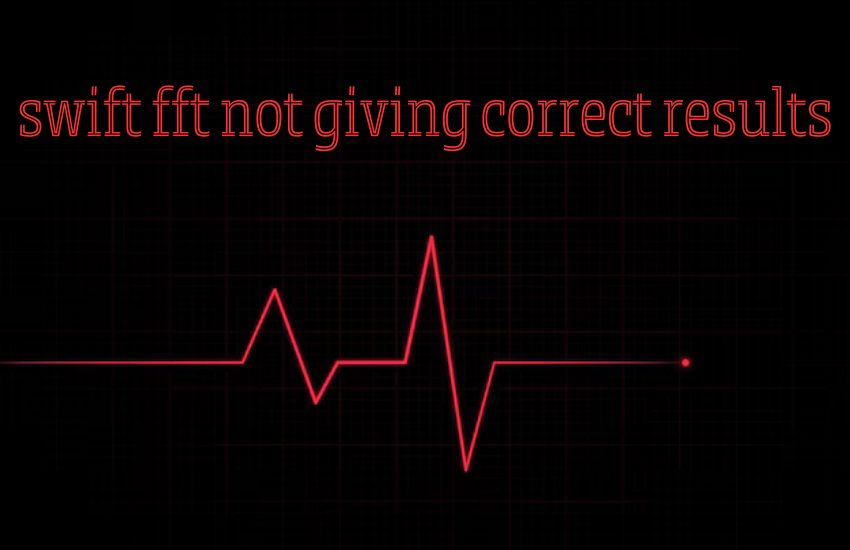Common FFT Libraries in Swift
2.1. Accelerate Framework
The Accelerate Framework provides a highly optimized FFT implementation, making it the go-to choice for many Swift developers. It includes DSP (Digital Signal Processing) functions like real and complex FFT.
2.2. Custom FFT Implementations
In certain cases, developers may implement their own FFT algorithms. Custom implementations offer flexibility, but performance and accuracy may not match what you get from optimized libraries like Accelerate.
Understanding the Fast Fourier Transform (FFT)
3.1. What is FFT?
3.2. Applications of FFT in Signal Processing
FFT is used in numerous fields like audio analysis, communications, image processing, and physics. Understanding its basic mechanics is crucial for debugging when it fails to provide accurate results.
Why is Your Swift FFT Not Giving Correct Results?
Several factors could lead to incorrect results in an FFT computation. Below are some common pitfalls:
4.1. Incorrect Input Data
FFT expects the input data in a certain format, usually as real or complex numbers. If your data is not properly pre-processed, the FFT algorithm may not yield meaningful results.
4.2. Misunderstanding the Output Format
The output of FFT consists of complex numbers. The magnitude and phase must be extracted carefully, and misunderstanding this can lead to incorrect analysis of the results.
4.3. Improper Scaling
FFT results need to be properly scaled, especially when converting between time and frequency domains. Incorrect scaling often results in amplitude errors.

Detailed Look at the Accelerate Framework for FFT
The Accelerate Framework is Apple’s highly optimized set of mathematical libraries, including FFT functions for both real and complex data.
5.1. Overview of Accelerate Framework
The Accelerate framework simplifies many complex operations, including FFT. However, ensuring correct usage is essential to avoid incorrect results.
5.2. Setting Up FFT in Accelerate
Setting up FFT involves creating a setup object (FFTSetup) and providing input in a specified format, either real or complex arrays.
5.3. Real vs. Complex FFTs in Accelerate
When performing FFT on real data, Accelerate returns a complex result. Developers often overlook the fact that only the first half of the array contains unique information due to the symmetry in the Fourier Transform of real inputs.
Troubleshooting Incorrect FFT Results
To fix FFT issues in Swift, you need to methodically check each part of the setup and execution process.
6.1. Ensuring Proper Input Format
Your input data should be pre-processed correctly. For example, audio signals might need to be windowed to avoid spectral leakage.
6.2. Verifying FFT Output Interpretation
Ensure that you are correctly interpreting the output, especially with complex results. The real part and imaginary part should be combined to compute magnitudes.
6.3. Correctly Handling Frequency Domain Data
The FFT output is symmetrical for real inputs. Only the first half of the result contains useful information about the frequency components.
Correcting Scaling Issues in FFT
Scaling is a common issue when transforming data from time to frequency domains and back.
7.1. Normalization of FFT Results
If you’re not normalizing the FFT result, the output amplitudes will not be accurate. Typically, you divide the FFT result by the length of the input signal.
7.2. Dealing with Windowing Functions
Using a windowing function (e.g., Hamming, Hanning) helps reduce spectral leakage but requires adjusting the scaling factor.
Real vs. Complex Data: Common Mistakes
8.1. Real Input FFT
When performing FFT on real inputs, it’s important to remember that the result will contain redundant data. Only the first half of the result array is relevant.
8.2. Complex Input FFT
For complex inputs, the result is directly interpretable across the entire array without symmetry.
Sampling Rate and Aliasing Issues
9.1. Understanding Sampling Theorem
Incorrect sampling rates lead to aliasing, where higher frequencies are misrepresented as lower frequencies in the FFT output.
9.2. Preventing Aliasing in FFT
Ensure the sampling rate is at least twice the highest frequency in your signal (Nyquist rate) to avoid aliasing.
Debugging FFT Results in Swift
10.1. Using Swift Playgrounds for FFT Debugging
Swift Playgrounds is an excellent environment for experimenting with FFT results in real time.
10.2. Visualizing FFT Results
Visualizing the FFT result can help in identifying errors. Libraries such as Charts can be used to plot the magnitude of frequency components.

Best Practices for Accurate FFT Results
11.1. Using Appropriate Windowing Functions
Windowing functions help to reduce spectral leakage, a common problem when dealing with FFT on finite data.
11.2. Handling Edge Effects
Edge effects can distort your FFT results. Applying a taper or windowing function can mitigate this issue.
Alternative FFT Libraries for Swift
12.1. FFTW (Fastest Fourier Transform in the West)
FFTW is another highly optimized FFT library that can be integrated into Swift projects via bridging headers.
12.2. KissFFT (Keep it Simple, Stupid FFT)
KissFFT is a lightweight, simple FFT implementation that can be included directly in Swift code.
FAQs About FFT in Swift
- Why is my FFT output mirrored?
- FFT of real signals is symmetric. You only need the first half of the data.
- Why are the FFT amplitudes incorrect?
- Incorrect scaling of the FFT result is the usual cause. Normalize the output by the length of the input signal.
- Why do I see unexpected frequencies in the output?
- This could be due to aliasing or improper sampling rates.
- What is spectral leakage?
- Spectral leakage occurs when a finite signal is transformed without applying a window function, spreading energy across frequencies.
- Can I use FFT for real-time audio processing?
- Yes, but you need an efficient implementation like Accelerate to handle real-time data.
- How do I choose the right windowing function?
- The choice of window depends on your application. Hamming and Hanning windows are popular choices for general signal processing.
Conclusion and Final Thoughts
Understanding FFT in Swift requires careful attention to input formatting, output interpretation, and proper scaling. By following the steps outlined in this guide, you should be able to resolve any issues with incorrect FFT results in Swift.


